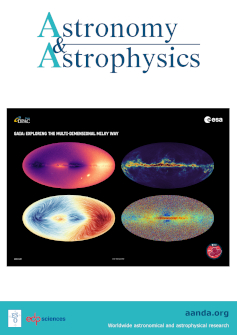宇宙距离上的微透镜效应:MACS 0416的沃霍尔弧的事件速率预测
IF 5.4
2区 物理与天体物理
Q1 ASTRONOMY & ASTROPHYSICS
引用次数: 0
摘要
高度放大的恒星(μ bbb100)现在通常被识别为宇宙距离的瞬变事件,这要归功于星系团临界曲线附近的星团内恒星的微透镜效应。利用詹姆斯·韦伯太空望远镜(JWST)和哈勃太空望远镜,我们在这里概述了一个应用于MACS 0416星系团(z = 0.396)的沃霍尔弧(z = 0.94)的分析框架,迄今为止已经发现了十几颗微透镜恒星。这种方法是通用的,可以应用于其他的透镜弧。在这个透镜星系中,我们拟合了8个JWST-NIRCam滤波器和3个ACS滤波器跨越的空间分辨光谱能量分布,以准确地在2D中预测透镜恒星。有了这个工具,我们可以生成微透镜恒星的二维图,一般来说,可以很好地分辨弧,结合波长依赖性和限制视星等。这些地图可以直接与JWST和哈勃望远镜计划的有节奏的活动进行比较,提供了一种限制初始质量函数和暗物质子结构水平的方法。本文章由计算机程序翻译,如有差异,请以英文原文为准。
Microlensing at cosmological distances: Event rate predictions in the Warhol arc of MACS 0416
Highly magnified stars (μ>100) are now routinely identified as transient events at cosmological distances thanks to microlensing by intra-cluster stars near the critical curves of galaxy clusters. Using the James Webb Space Telescope (JWST) in combination with the Hubble Space Telescope, we outline here an analytical framework that is applied to the Warhol arc (at z = 0.94) in the MACS 0416 galaxy cluster (at z = 0.396), where over a dozen microlensed stars have been detected to date. This method is general and can be applied to other lensed arcs. Within this lensed galaxy, we fit the spatially resolved spectral energy distribution spanned by eight JWST-NIRCam filters combined with three ACS filters, for accurate lensed star predictions in 2D. With this tool we can generate 2D maps of microlensed stars for well-resolved arcs in general, incorporating wavelength dependence and limiting apparent magnitude. These maps can be directly compared with planned cadenced campaigns from JWST and Hubble, offering a means to constrain the initial mass function and the level of dark matter substructure.
求助全文
通过发布文献求助,成功后即可免费获取论文全文。
去求助
来源期刊

Astronomy & Astrophysics
地学天文-天文与天体物理
CiteScore
10.20
自引率
27.70%
发文量
2105
审稿时长
1-2 weeks
期刊介绍:
Astronomy & Astrophysics is an international Journal that publishes papers on all aspects of astronomy and astrophysics (theoretical, observational, and instrumental) independently of the techniques used to obtain the results.
 求助内容:
求助内容: 应助结果提醒方式:
应助结果提醒方式:


